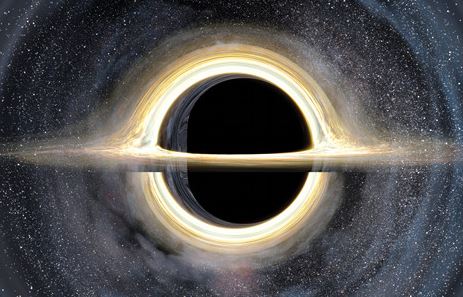New insights into the powerful effects of black holes have been provided by the technology used by the visual effects team involved in making the epic Oscar-nominated movie Interstellar.
The visual effects experts described how their specially-created computer code was used to generate the movie’s iconic images of the black hole, the wormhole and other celestial bodies in the journal Classical and Quantum Gravity.
The authors, from London-based firm Double Negative, as well as Kip Thorne, a theoretical physicist who works at Caltech (California Institute of Technology), explained how their innovative code helped them make new scientific discoveries.

Gargantua, the fictional supermassive black hole in the movie Interstellar, with a mass 100 million times that of the Sun.
They found that when a camera is close to a rapidly-rotating black hole, the caustics create several images of individual stars in the bright, thin plane of the galaxy where the black hole is located.
The images are concentrated along one edge of the black hole’s shadow, when it drags space time into a whirling motion and stretches the caustics around itself many times.
How would a person close to a black hole see it?
Never before have the effects of caustics been computed for a camera close to a black hole. The images tell us what it would be like for a human being orbiting a black hole when looking around and into it.
The visual effects team’s computer code mapped the paths of millions of beams of light and their evolving cross-sections as they passed through the warped spacetime of Gargantua, the movie’s fictional supermassive black hole with a mass 100 million times that of the sun, thus making the discovery possible.
The visual effects engineers were able to create images of the movie’s black hole and wormhole thanks to the computer code they created, as well as its accretion disk, with amazing smoothness and clarity.
An accretion disk is a flat gas, disk-like structure that spirals rapidly around a larger celestial object, such as a black hole, white dwarf star or new star.
The computer code allowed them to see parts of the accretion disk swinging down below and over the top of Gargantua’s shadow, as well as in front of the shadow’s equator, which produced a picture of a split shadow that has become iconic for the movie.
Gravitational lensing
The glowing disc’s mysterious distortion is caused by gravitational lensing – when the rays of light from a bright and distant object are distorted around a black hole and between the bright object and the viewer – before they arrive at the movie’s simulated camera.

Oliver James is Chief Scientist at Double Negative.
Einstein, in his theory of general relativity, predicted gravitational lensing.
This lensing literally bends the fabric of spacetime around itself, as occurs when a heavy ball is placed on a tightly-stretched bed sheet.
When the visual effect’s team were making Interstellar, with the black hole surrounded by a rich field of distant stars and nebulae instead of an accretion disk, they found that the standard approach of utilizing just one ray of light for one pixel in computer code – which meant 23 million pixels in total for an IMAX picture in this case – resulted in the flickering of the nebulae and stars across the screen.
Double Negative Chief Scientist, Oliver James, said:
“To get rid of the flickering and produce realistically smooth pictures for the movie, we changed our code in a manner that has never been done before. Instead of tracing the paths of individual light rays using Einstein’s equations – one per pixel – we traced the distorted paths and shapes of light beams.”

Kip Thorne is the Feynman Professor of Theoretical Physics at Caltech.
Mr. Thorne, who was also co-author, said:
“This new approach to making images will be of great value to astrophysicists like me. We, too, need smooth images.”
Mr. James commented:
“Once our code, called DNGR for Double Negative Gravitational Renderer, was mature and creating the images you see in the movie Interstellar, we realized we had a tool that could easily be adapted for scientific research.”
They used DNGR to carry out several research simulations exploring the influence of caustics on the images of distant star fields as seen by the camera in the proximity of a rapidly-rotating black hole.
Mr. James said:
“A light beam emitted from any point on a caustic surface gets focussed by the black hole into a bright cusp of light at a given point. All of the caustics, except one, wrap around the sky many times when the camera is close to the black hole.”
“This sky-wrapping is caused by the black hole’s spin, dragging space into a whirling motion around itself like the air in a whirling tornado, and stretching the caustics around the black hole many times.”
A caustic when passing a star creates or eliminates images
When a caustic passes a star it either creates two new images of it, or eliminates the old images of the star, as far as a the camera is concerned.
As the camera progressed through its orbit around a black hole, the DNGR video footages showed that the caustics continuously created and ate up a huge number of star images.
Mr. James and colleagues identified up to 13 simultaneous images of the same star, and also up to 13 images of the bright, thin plane of the galaxy where the black hole resided.
The multiple images were only created when the black hole was rotating rapidly and only on the near side of it, when its moving space was going in the direction of the camera, which the engineers deduced was due to space throwing the images outward from the black hole’s shadow edge.
Conversely, on the other side of the shadow, where space was traveling away from the camera, they deduced that although the multiple images of each star were there, the whirl of space had squeezed them inward, so close to the shadow of the black hole that they could not be seen in the simulations.
Video – Starfield under the influence of gravitational lensing 1
Video – Starfield under the influence of gravitational lensing 2
Video – Starfield under the influence of gravitational lensing 3

